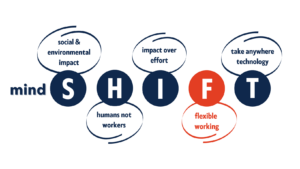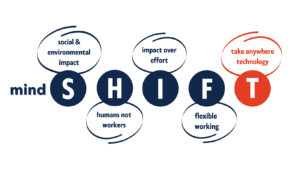The energy industry is in a state of transition. Change is inevitable for all legacy energy providers but to achieve an effective transition we need to consider how to engage people resistant to change. And, think about how pandemic led changes can help to imagine a future that’s meeting the needs of employees, communities and the businesses operating in the industry.
What is needed is a mindSHIFT in the energy industry.
A sign of the times
On 19 February 2022, Australian start-up entrepreneur, Mike Cannon-Brookes and Canadian asset management company, Brookfield, proposed a takeover of Australia’s ‘biggest polluter’ AGL Energy’. The A$3.5 billion bid was rejected by the board of AGL, but Cannon-Brookes remained optimistic that an agreement could be reached with the supplier. Cannon-Brookes wants to substantially accelerate the end of AGL’s coal-fired power stations in Australia, 12 years ahead of AGL’s plan.
The takeover bid is timely. It raises the profile of renewable energy in the lead up to the Australian federal election as well as reflecting a general attitude change on energy issues across the country.
While politicians seek to retain the status quo and protect coal mining jobs and production, business groups and citizens alike are all indicating their interest in renewable energy prioritisation.
The Business Council of Australia’s Living on Borrowed Time (June 2021) discussion paper noted that;
“we must make the investments now that will both leverage existing technologies to rapidly decarbonise, and lead to new technological breakthroughs so we can lead the world in producing low and zero carbon technologies.”
As the organisation representing the biggest companies employing people in the country, the Business Council’s strident criticism is telling. They reject Australia’s ‘rich, dumb and getting dumber‘ attitude to its investments and reliance on traditional commodities like coal.
The Council, and other international groups, have noted that the economics of the energy sector have shifted entirely. World energy demand (based predominantly on fossil fuels) is falling year on year. Jobs in the fossil fuel industry are also declining dramatically, as humans are replaced by automated systems across the board. In the meantime, jobs in renewables are expected to eclipse those in fossil fuels within the next five years.
Leaving aside all of the climate change impacts of sustaining coal-fired power plants at AGL until 2050, there are serious questions about whether there will be any demand at all for coal by that date. The plants may have to close long before the planned horizon.
Energy sector changes and the mindSHIFT
It’s not just the economics that have shifted in the energy sector, of course several other aspects of the industry are changing and these can be mapped, using the mindSHIFT framework:

Social impact:
The energy sector is inevitably associated with climate change and the impact of the fossil fuel industry. 60% of Australians believe that global warming is a serious issue and requires action even if this involves ‘significant costs‘.
Attitudes to energy production methods are shifting as the practical impact of climate change on personal choices becomes clear. Everything from where we live, to what we eat is affected, so the social impact of energy production is a rising issue.

Humans not workers:
Job losses in the coal mining industry are a point of concern in rural communities where employment in the sector underpins the economic viability of the town. But jobs have been lost to automation over decades in the historically dangerous coal mining industry. While unions have traditionally taken care of workers’ interests, in a rapidly declining workforce, it is the human impact of the changes taking place in the sector that need greater attention.
And initiatives like the Cannon-Brookes and Brookfield takeover bid for AGL are designed to sustain jobs in these towns, and protect the communities that have grown around the industry. Employees will need to be re-trained but their communities will be sustained, if the changes to the sector can be done in situ. Such initiatives do recognise the human costs and the opportunities of transformation.

Impact over effort:
The energy sector has always been focused on ways to create the greatest output with the least effort but the shift to renewable energy is the very definition of impact over effort.
Where the shift is affecting business practices, the issue is ensuring that the impact of transformation meets energy production and storage needs with the least effort of changing; tools, resources and staffing. This is possibly the least sophisticated aspect of the energy transformation program, and as such it requires more thinking and change communication.
The best way to get people to change is to tell them almost nothing is changing. That’s not the message coming through the energy sector right now but it still can be, with the right change management.

Flexibility:
Again, this is a regularly discussed problem when considering transformation – of the energy sector – particularly when it comes to energy capture, storage and feeding of power.
The commonly told story is that transformation will actually result in a loss of flexibility in energy supply. But again we need to think about flexibility of business practice in the transformation process, rather than the supply of energy itself (and the risk of supply being inflexible may also be overstated).
There is also a shift playing out across the sector of a workforce that is unbound by location, that this may have an impact on communities where existing coal-fired power stations (such as AGL’s) are located. But there are ways that energy suppliers can attract communities around the new plants (that supply other energy types) such as; developing ecosystems of experience and culture that will attract those people who wish to be employed by the companies to these bustling townships, creating an opportunity for new employees to embrace a tree change, as well as providing more flexibility to locals.

Technology:
Finally the changes to the technology landscape around the energy sector are profound.
From batteries, charging stations and energy monitors to household energy production maintenance kits, the energy industry’s technologies continue to grow. And, there will be ongoing innovation around the tools of capture and supply.
From a transformation perspective, there is fertile ground for continuing technological development, especially in terms of predictive data, community battery supply management for apartment blocks, for smaller communities and backup system management.
Did you know?
An Australian company is one of the world’s largest charging station suppliers: Tritium Charging
Changing minds that don’t want to change
So, if the energy industry is facing such a monumental shift in economic value, business practice and supporting industry activity, how might we bring about a change in the mindset of business representatives in the sector who are resisting change?
Here’s how the mindSHIFT toolkit can help shift perceptions and practices:
1. The Working Life Canvas: is designed to capture the experiences, values and desires of individuals.
For individuals employed by or directly affected by legacy energy systems, this canvas maps ways their lives have changed, as a direct result of the pandemic, and it encourages thinking about; how their lives might shift, looking ahead to 2025.
The objective is not to consider changing the way their business works, or bombard them with information, but to observe how their lives have already changed, and to see what aspects of those changes they want to retain. This helps them to identify changes they appreciate, and to set boundaries for the kind of working environment they want to experience in years to come.
2. The Workplace Blueprint Canvas: captures policies, cadence and strategies of a place of work.
For businesses invested in legacy energy sources, this provides a snapshot of how the workplace operated before, during and after the pandemic, and seeks to identify gaps in workplace policy and technology that will emerge as the culture of the workplace changes.
Again, the objective is not to directly press for changes in energy supply, but rather to prepare for future changes in a manner that will make transition more acceptable and comfortable.
3. The mindSHIFT Alignment Checklist: provides a framework for identification of gaps in alignment between employee experience and workplace strategy.
This alignment checklist should be completed alongside any roadmaps for transition, with key transformation opportunities set against the desires and capability of the workforce.
This enables leaders to consider how employee needs may be addressed through retraining and repositioning within the organisation, and to deploy automation and other transformation activities which better align with employee wishes and vision for the future.
Affected by the energy sector’s changes? Want to know how to shift and change minds that don’t want to change? Contact us.



